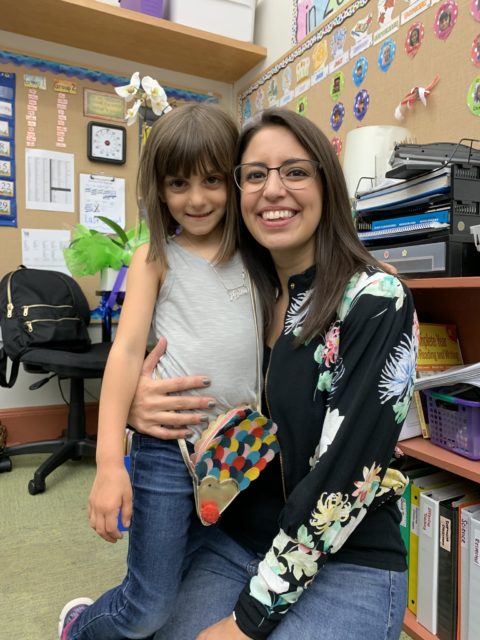Harlow just completed first grade (eek!) and although she still has a way to go before I would say she is officially “reading,” she has worked so hard and made so much progress this year. I am really proud of her. One person I have to thank for Harlow’s love of school is definitely her teacher this past year. Alli has been such a positive influence on Harlow and brings so much fun to the classroom. I asked her for tips about ways to prevent the “summer slide” and she did me one better— she wrote a post! Please give a warm welcome to Harlow’s first grade teacher who wrote the tips below. We’ll miss you, Alli!
Teachers and students both look forward to that bittersweet last day of school before Summer Break. We are sad to see a chapter end, but also excited about what we’ve learned together and the adventures to come.
As a teacher in the elementary grades, I often get asked for tips to keep up the learning momentum and prevent that dreaded Summer Slide. For those of you who are new to this term, the Summer Slide refers to a decline in reading ability and/or other academic skills when school is no longer in session. Young children benefit from the daily repetition that school provides over 10 months. So, what happens over the 2 months of summer? How can we help children maintain what they’ve learned the year before, so they come back in the fall and are able to pick up exactly where they left off?
Your child doesn’t need year-round schooling to stay on track and prevent the Summer Slide. Even as a teacher, I believe that Summer should be Summer— a time to sleep in, enjoy family and friends, stay up a little later, and create lasting memories. With that said, I also believe there are a variety of fun and engaging ways to incorporate learning into your child’s summer that won’t make them feel like they’re back in the classroom.
5 Ways You can Help your Child Prevent that Summer Slide:
1) Read together everyday
It all starts with selecting the “right” book. No matter how many books take up space in your home, there’s nothing like picking out your own book and taking ownership of your reading. Instead of spending money on new books that will continue to crowd your shelves, take your child on weekly trips to your local library.
Depending on the age of your child, reading together may look different. The main goal is to foster a love of reading, whether that means your child is reading, you are reading, or you take turns. If your child prefers for you to read, don’t fret! This is an opportunity for you to share your love of reading, model a strong reader voice, and engage your child by asking related questions about the story elements (character, setting, problem, and solution). You can also introduce chapter books by reading one together over an extended period of time, retelling the story each time you pick it up, sharing how characters may be feeling, and making predictions of what you think is to come. Another exciting way to find new books is through the digital library app called “Epic!” There are tons of books at every level for all genres.
2) Turn Reading into a Game
Many simple games incorporate elements of reading, so you can reinforce school skills without your child even realizing it. You can even create your own games to hone in on specific skills. For instance, if your child has a list of sight words they learned the previous year, work together to write these out on index cards. With flashcards, students can read each word, put them into sentences, and even act them out! If you make two of each, you can play “Concentration” by laying them all face down in an array, while trying to find each match. Early readers can try this by matching a letter to a picture with that beginning sound. Another tip is to label different parts of your home, such as “cabinet” or “door” and encourage your child to read it before opening. This can also work for learning or reviewing another language! While you are out and about, ask your child to read signs along your walk or product labels at the grocery store. Words are all around us.
3) Turn Math into a Game
We all use numbers everyday, whether we’re cooking in the kitchen, shopping, navigating directions, or helping our children with math games. Children can partake in these opportunities by following a recipe with you in the kitchen, creating their own store with pretend money, reading subway maps or navigation systems on long drives, keeping track of the time on a road trip or making their own fun math games to play throughout the summer.
For those interested in linking math and technology, some suggested apps to engage your child are “Komodo Math,” “Base Ten Blocks,” “Math Ninja,” and “MathTappers.” I suggest looking into these first and introducing one at a time to your child based on their learning needs.
In the early grades, children learn to skip-count by 2s to 20+, 5s to 50+, and 10s to 100+ in order to help them make sense of number patterns and gain a better understanding of how numbers work together. Your child can create flashcards by selecting a number pattern and labeling each card using a number line or 100s chart as a guide. Then, you or your child can set these cards up like a life-sized game board on the floor for your child to hop and count! This incorporates movement, counting, and lots of laughs. Children can count up to a desired number and backwards. They can even switch roles and challenge you to conquer their counting quest. For more of a challenge, they can try other number patterns such as 3s, 1st to 100, or even by 2s starting with 1.
4) Keep a journal
A personal writing journal is a great way to encourage your child to continue writing throughout the summer. Give them immediate ownership of their journal by allowing them to pick out their own. The goal is to foster their love of writing. You can do this by giving your child a creative space to reflect on their recent experiences (for some nonfiction writing) or express their active imaginations through fictional writing. For those natural storytellers who are eager to publish their writing, I recommend the website “Write Reader.” This gives your child a platform to type out their stories, add pictures, utilize text features, and print them out to share!
In order to prevent push-back, this should only happen about 2-3 times a week, unless your child wishes to write more. You can pick these writing dates together by marking them on a calendar and holding them accountable. You can also set a timer for 15-25 minutes for writing, depending on your child’s age and stamina. I would also suggest having your child date each entry as it may be something fun to look back on in the future!
5) Turn Your Everyday Adventures into a Learning Opportunity
The best way to avoid the Summer Slide is by finding learning opportunities in your child’s everyday interests. Go for a walk, venture on a hike, or explore a new part of your city! Use these fun experiences in the great outdoors to explore the scientist within your child. Make observations of what you see, hear, smell, feel, or taste. Ask questions and encourage them to do the same. Collect leaves, rocks, or anything that draws your child’s attention. Give them your phone or camera to take photos of objects or scenes that interest them and then ask them about it. The goal is to engage your child in the here and now, by fully interacting with their surroundings. They can write about it in their journal or they may want to take out a book from the library that aligns with their newfound interests.
Over the summer, the most important thing is to keep learning casual and fun. Be encouraging, ask lots of questions and make your child feel like it something you are doing together, not on their own. By keeping these tips in mind and your child’s interests at heart, you’re already a big step closer to preventing the Summer Slide!

























